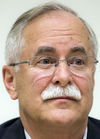Originally published November 15, 2014 at 7:00 PM | Page modified November 16, 2014 at 3:45 PM
Oso slide, wildfires prompt DNR bid to boost budget
Commissioner of Public Lands Peter Goldmark says his budget requests for wildfire fighting and landslide mapping are about protecting people. But the list comes as lawmakers face other enormous funding issues.
Seattle Times Olympia bureau
![]()
OLYMPIA — Washington residents this year endured two natural disasters with little precedent: the Snohomish County landslide in March that killed 43 people, and the wildfires in the summer that destroyed hundreds of homes in Central Washington.
In response, the state Department of Natural Resources (DNR) is requesting more money to prevent and fight fires, as well as funds to use aerial mapping of land to find potentially dangerous areas for landslides and other geologic hazards.
For Commissioner of Public Lands Peter Goldmark — who oversees the DNR — the requests would help protect people from future disasters. But Goldmark’s wish list comes as lawmakers already face serious funding problems.
Legislators must find money for the state Supreme Court decision requiring up to $2 billion for education spending, more than $300 million to fix psychiatric boarding conditions, $750 million or more for proposed state-employee and teacher-pay raises and other obligations. None of which includes Initiative 1351, which voters passed to fund smaller class sizes; it adds several billion dollars more to the tab.
“The list goes on and on,” Goldmark said Friday.
“I know there are many other emphatic requests, but public safety has to be at the high list of many legislators’ minds,” he added. “It’s clearly on mine. I feel the responsibility acutely. And I need their help.”
The DNR, according to Goldmark, will request about $6.5 million for aerial photography and radar mapping to find areas prone to landslides and other geologic hazards; about $18 million to prevent wildfires; and $4.5 million for new wildfire-fighting resources such as staff, training and equipment.
Money in that last category would help the state fight fires such as the summer’s Carlton Complex wildfires, which destroyed more than 300 homes in Central Washington. The cost of properties destroyed in Okanogan County alone is estimated to be more than $28 million.
Last budget session, Goldmark says he asked legislators for $2 million for such wildfire resources — which lawmakers denied.
It was a frustrating rejection heading into the wildfire season, according to Goldmark.
“We were resource-short, particularly during Carlton Complex,” he said. “We didn’t have the resources we needed to do the initial attack to ensure success.”
“We need to have more firefighters and we need to have more training and we need a certain amount more equipment,” Goldmark said.
Goldmark, who didn’t want to speak to whether lawmakers needed to find ways to generate more revenue, is also asking for $70 million in supplemental budget funding to pay for the costs of fighting this year’s wildfires.
Even before those fires struck, the state was grappling with the tragedy of the Oso landslide.
The DNR request for aerial photography and mapping that uses a laser-surveying technique known as lidar would provide for 14 workers to map geology and collect and analyze such data to better understand landslide hazards. The lidar technique builds images that strip away vegetation to expose the landforms below, and some counties have used them to find hazardous areas.
That money would also create a central database for lidar data, and provide for modeling potential tsunami hazards.
“This is just for those areas that are judged to be high-risk to populated areas or to infrastructure,” Goldmark said.
The Forest Practices Board, an independent state agency, approved a resolution last week in support of the DNR’s budget requests. Aaron Everett, the board’s chairman, acknowledged it would be a tough year to ask lawmakers for money.
“I think the department decided that we needed to make some pretty significant budget requests, despite, and in full recognition of, the difficult budget situation that we face,” said Everett, who was appointed by Goldmark to lead the board.”
“The thinking on that is if we’re not asking for it, it’s simply not going to happen.”
Material from The Seattle Times archives is included in this report. Joseph O'Sullivan: 360-236-8268 or josullivan@seattletimes.com Twitter @OlympiaJoe
 Four weeks for 99 cents of unlimited digital access to The Seattle Times. Try it now!
Four weeks for 99 cents of unlimited digital access to The Seattle Times. Try it now!
















